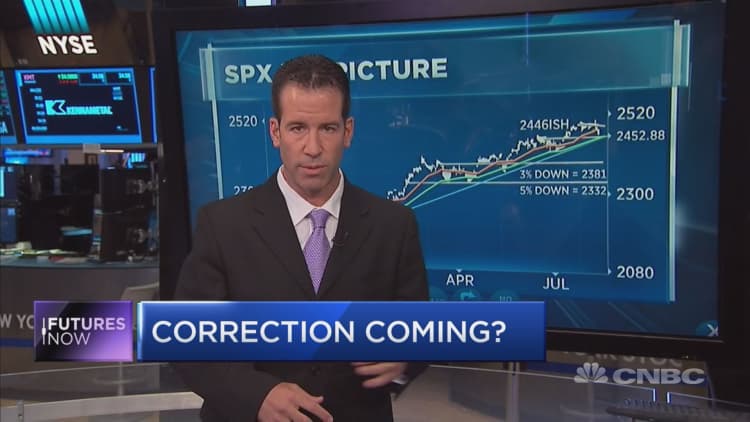
Stocks are likely to take more of a beating, in what could be the first major shakeout of five percent or more in a year.
Worries about rising tensions between the U.S. and North Korea toppled a market that has been considered richly valued and too complacent. This week, a number of major financial firms, including Citigroup, and all called for based on high valuation and the fact the Fed is about to reverse some of its easy policy.
Stock futures were lower Friday after the tumbled 204 points Thursday to 21,844 in its worst trading day since May 17. The selloff comes after a series of new highs in a summer of low volatility. The fell 1.5 percent to 2438 Thursday, while the took the biggest hit, losing two percent to 6,216.
"The fact is it's very abnormal to go an entire year without a five percent correction, and we haven't had one since the top last August and a trade down to the day before the election. From that perspective, what we're telling people is if you measure your investment horizon in years, like most investors do, you just have to relax and expect to have a lower entry point to add to your equities holdings," said Julian Emanuel, equity and derivatives strategist at UBS. "If you measure your horizon in weeks, or months, you want to be a little more defensive here."
Emanuel said the S&P 500 could lose another 100 points or so before the selling ends. "Five percent gets you to 2375. The logical support point is the 200-day moving average, which we last touched on Election Day," he said. The 200-day was at 2337 on Thursday.
"To us that would be a point where you want to think about increasing your exposure. We don't think this is a bear market. We don't think this is the start of a bear market because we don't see a recession on the horizon, but … at this time of year it's very typical for typical for the market to get wobbly and liquidity at this time of year is not great because quite simply there are so man y out of office emails when we try to contact our clients," Emanuel said. "People would prefer to the be on the beach than looking at their portfolios. That can create vacuums like we've seen today."
Sam Stovall, chief investment strategist at CFRA, agreed that around the 2337 level is a logical support level for the S&P, and he too expects the selling to continue. Stovall said the last major selloff was the more than 10 percent correction that ended in February, 2016.
"Normally we have pullbacks at least once a year, corrections every year and a bear market every four-plus years," he said. A pullback is a five to 10 percent selloff, while a correction is 10 percent or more.
Analysts said Friday could be choppy as well, as investors hunker down and hedge positions ahead of the weekend.
"We were looking for a pullback. Statistically, this is the period where the market tends to pull back....you had a tired market, an overbought market. It's almost like the market was waiting for something to hit, and it did — a geopolitical test," said Prudential Financial chief market strategist Quincy Krosby.
Krosby said the question now is whether in, a phenomena that could keep a sell off relatively shallow.
Stovall said he does not expect a bear market to develop.
"When I look at housing starts, consumer sentiment, [leading economic indicators] and the yield curve, they all tell me now we're not near a recession. If we do have a sharp decline, it's based on the market worrying a recession will occur because of some fallout from nuclear tensions," he said.
As stocks sold off, investors moved into safety trades, like Treasurys and gold. High-yield debt also sold off.
Neha Khoda , Bank of America Merrill lynch high yield credit strategist, said there was heavy selling in high yield ETFs, and spreads widened between high yield bonds and Treasurys. The iShares iBoxx High Yield Corporate Bond ETF HYG fell 0.6 percent Thursday.
"I think people were feeling a little concerned about valuations in high yield," she said. "You could say they were a little bit concerned, but I think the direction has certainly changed in the last two days. … Having said that, the only caveat I would make here is ETFs are usually the first to react in any sort of uncertainty. Whether the change is good or bad, ETFs are the first to react."


